A luxating patella in dogs (i.e. a kneecap that slips out of place) has the potential to limit your dog’s mobility and cause pain over time. Integrative veterinarian Dr. Julie Buzby explains why patellar luxation occurs, the grades of patellar luxation, and how best to help and support your dog with a luxating patella.

Do you ever watch your dog while he or she walks? For some of us, it’s interesting to think about the science behind how our four-legged friends move from place to place. Slightly more weight is placed on the forelimbs compared to the hind limbs, but in general, all four limbs are used for things like walking, running, and playing.
But what if your canine companion suddenly picks up one of the hind limbs for a few steps then puts it back down again? At first you may wonder if he or she could have stepped in something. But could it be a sign of a bigger issue with the leg like a luxating patella?
- What is a luxating patella in dogs?
- What causes a luxating patella?
- What are the types and grades of luxating patella in dogs?
- What are the signs of a luxating patella?
- How does the vet diagnose a luxating patella?
- What is the treatment for a luxating patella?
- Luxating patella dog surgery
- Talk to your veterinarian about luxating patella options for your dog
- Does your dog have a luxating patella?
What is a luxating patella in dogs?
As the name might imply, a patellar luxation occurs when the dog’s patella (i.e. kneecap) moves (i.e. luxates) out of its normal anatomical position. Once the patella luxates, the hind limb cannot fully extend. This most commonly results in your dog holding the leg up while the knee is in a flexed position. If the patella pops back into position, the dog can begin to use the leg more normally again.
The patella can slide medially (going toward the inner surface of the leg) or laterally (going toward the outer surface of the leg). Luxating patella can affect one or both knees in dogs. It is also one of the most common orthopedic conditions in veterinary medicine.
To further understand how luxating patella affects a dog’s mobility, let’s review the anatomy of a dog’s knee.
Dog knee anatomy
The knee joint (i.e. stifle joint) is the space between the femur (i.e. thigh bone) and the tibia (i.e. shin bone). There are several important ligaments that help to keep the bones lined up with one another when your dog walks.
One such ligament is called the cranial cruciate ligament. This firm band of connective tissue starts at the back of the femur, crosses the joint, and attaches to the front of the tibia. It is the ligament that is affected by a torn ACL in dogs. There are also three fibrous sacs called joint capsules that enclose the stifle joint for protection.
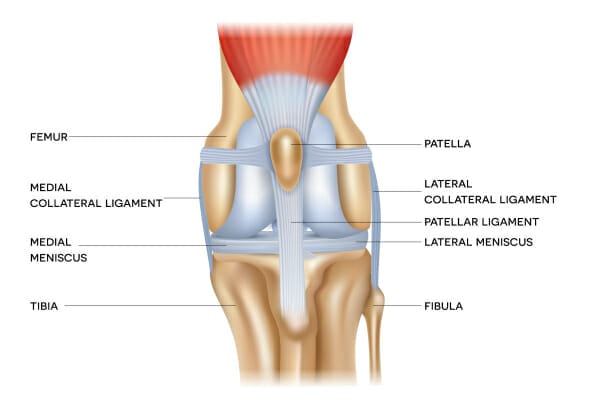
The patella is located inside of the large tendon that comes down from the quadriceps muscles. These are the big muscle bodies that surround the femur, making up a large portion of your dog’s thigh. The quadriceps muscles help extend your dog’s hind limb, making the leg perfectly straight. Then, when the muscles relax again, the knee can bend.
When a normal dog’s hind limb is fully extended, the patella rests in the trochlear groove. This is a small notch within the part of the femur that is closest to the knee. As the limb flexes, the patella will slide in a downward direction. Because the patella is inside of the patellar tendon, it should stay on track as your dog’s knee continuously flexes and extends.
However, in the case of a luxating patella, the kneecap will deviate from its normal up-and-down pathway by popping out of the trochlear groove. This tends to occur when:
- The trochlear groove is shallow
- The femur and/or tibia are rotated or bowed abnormally (i.e. malformed)
- Soft tissues (i.e. cruciate ligaments or joint capsules) surrounding the patella are abnormal
- Quadriceps muscles are too tight or patellar tendon is too loose
What causes a luxating patella?
Most likely, multiple factors contribute to the anatomical changes listed above that allow the patella to luxate. They may include:
- Traumatic injury (i.e. falling or being hit by a car)
- Genetic predisposition in certain breeds—which is why dogs with luxating patellae should not be bred
- Bone conformation abnormalities that develop as a dog grows
When a luxating patella occurs, it is important to think of it not as a solitary disorder that occurs in a vacuum. Rather, it probably comes from other musculoskeletal problems that affect the alignment of the hind limb. Some of these include hip dysplasia in dogs, angular limb deformities, and disorders of the quadriceps muscles. Conversely, bone changes and painful osteoarthritis in dogs can come from weight-bearing stresses as a result of the patella luxating all the time.
What are the predisposing factors?
While any dog can have a luxating patella, there are some identifiable risk factors. One of them is breed. Medial luxating patellae (i.e. where the kneecap deviates inward) are very common in toy breed and small breed dogs. These include Yorkshire Terriers, Boston Terriers, Pomeranians, Chihuahuas, and Miniature Poodles.

Lateral luxating patella seems to occur more frequently in senior small breeds or young, large breed dogs. Breeds predisposed to a lateral luxating patella include Chinese Shar Peis, Flat-Coated Retrievers, Great Pyrenees, and Akitas.
Another predisposing factor is having luxating patella in one leg. As it turns out, there is a 50% chance that the opposite knee will have the same problem.
Your dog’s body condition score (BCS) and diet as a growing puppy are also important factors. Being overweight as a puppy applies extra stress to bones and joints, which can predispose a dog to orthopedic issues. Also, if your puppy’s diet does not provide the correct levels of vitamins and minerals for bone growth, this can lead to limb malformations that can increase the risk of a luxating patella.
What are the types and grades of luxating patella in dogs?
Approximately 75% of dogs with a luxating patella will have a medial patellar luxation. The remaining 25% of dogs will have a lateral patellar luxation. In some cases of lateral luxation, the dog may also have a ruptured cranial cruciate ligament.
During a physical examination, your veterinarian will grade your pup’s luxating patella based on the location of the patella when the leg is at full extension. There are four grades of luxating patella, and they are as follows:
- Grade I—The patella is in a normal position. The vet can luxate it but it returns to the correct position as soon as the vet releases it.
- Grade II—As the knee flexes and extends, the patella will pop in and out of position. The vet can luxate the patella and then manipulate the limb to get the patella to return to the trochlear groove.
- Grade III—The patella is out most of the time. The vet can move it back into position but it pops out again immediately.
- Grade IV—The patella is permanently out of position and the vet cannot push it back in place again.
What are the signs of a luxating patella?
As you can imagine based on the different grades of luxating patella, the signs can be variable. Sometimes, dogs with a Grade I luxation are initially asymptomatic. Alternatively, it is fairly common for dogs with a Grade I or II medial patellar luxation to suddenly skip or walk on three legs when the kneecap luxates. After a moment, they may resume a normal stance if the patella pops back into place. This can occur intermittently or continuously. It may also be temporarily worsened if your pup jumps up on something and lands wrong.

Initially, lower-grade luxating patellae may not be very painful, but they can lead to painful health problems over time. Puppies with severe medial patellar luxations (Grade III or IV) tend to develop a bow-legged stance due to the abnormal forces across the stifle joint. The resulting joint instability contributes to cartilage damage and the development of osteoarthritis early in life. These dogs tend to be consistently, rather than intermittently, lame.
Dogs with lateral patellar luxations often have more trouble moving around than those with medial luxations. They may also have a knock-kneed stance (i.e. knees deviate inward).
If you are wondering “Why is my dog limping?” or you have any concerns with your dog’s gait or stance, please make an appointment with your veterinarian.
How does the vet diagnose a luxating patella?
At the appointment, your vet will probably start by getting a history from you, watching your dog walk, and performing an orthopedic exam (including manipulating the patellae). Your veterinarian will diagnose and grade the luxating patella based on the instability or movability of your dog’s kneecap.
Higher-grade luxating patellae are generally easier to palpate on exam. But it is possible to detect Grade I or II luxations as well. In some cases, your vet may recommend light sedation for your dog in order to perform a more thorough orthopedic examination.
Typically, your vet will primarily use the orthopedic exam to diagnose your dog’s luxating patella. However, there are cases where he or she may recommend advanced imaging. Your vet may use X-rays to evaluate the bones that make up the stifle joint. Or, he or she may recommend a CT scan to assess the soft tissues within the joint.
If your dog is going to undergo surgical correction of the luxating patella or will be on pain medications long term, your vet may also recommend additional diagnostics such as blood work and urinalysis. These tests help ensure your dog is healthy and able to tolerate the medication or procedure.
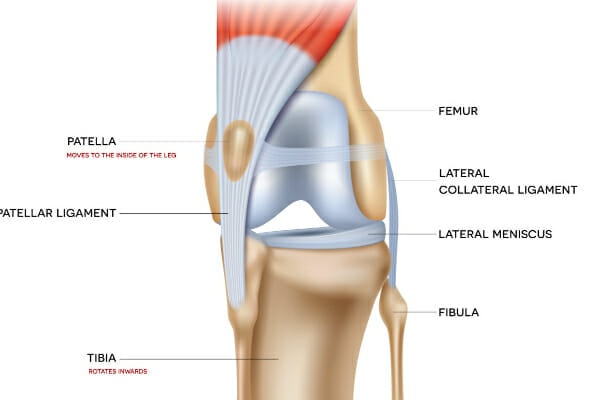
What is the treatment for a luxating patella?
As alluded to, there are several treatment options available for dogs diagnosed with luxating patellae. Many of these options are dependent upon the grade of luxating patella and how often you are noticing clinical signs. For example, dogs with Grade I and II luxating patella may respond to conservative treatments. However, dogs with Grade III and IV luxating patella (or significantly painful dogs with a Grade II luxation) may require surgery. But they can still benefit from some of the medical treatment modalities too.
Non-surgical options for patella luxation
Some of the medical options for managing patellar luxations include:
Pain medication
Most vets will prescribe an anti-inflammatory medication for pain control. Non-steroidal anti-inflammatories (NSAIDs) such as carprofen and firocoxib can help with pain by reducing inflammation of the soft tissues surrounding the patella. If your dog has liver disease in dogs, kidney disease, or another reason that NSAIDs may be contraindicated, your vet may end up recommending other pain medications such as tramadol for dogs or gabapentin for dogs. However, these medications may not be as effective as NSAIDs.
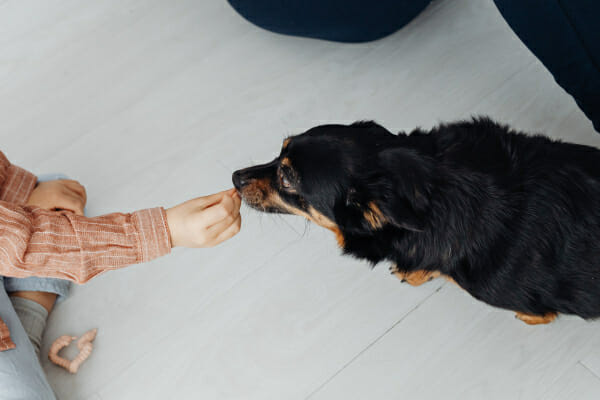
Luxating patella dog supplements
Your dog could also benefit from joint supplements for dogs. My personal favorite is Dr. Buzby’s Encore Mobility™ hip and joint supplement. It combines the unique benefits of green lipped mussel for dogs and New Zealand deer antler velvet for dogs. Together, these ingredients can help reduce inflammation, provide joint building blocks, and improve your dog’s comfort.
Save 10% on Encore Mobility™ Joint Supplement for Dogs
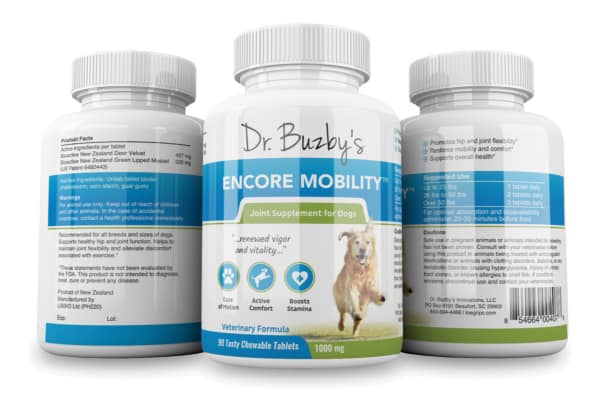
Give your dog more good days.
Use promo code HAPPY to save 10% on Encore Mobility.
Luxating patella dog braces
There is limited information on the benefits of dog knee braces for luxating patellae. Since cruciate ligament tears can occur in patients with luxating patellae, dog knee braces may potentially decrease the risk by supporting the limb and keeping the femur and tibia in alignment. The efficacy of dog ACL braces (for after a tear has already occurred) is controversial, so please consult with your veterinarian before deciding to order one.
ToeGrips for dogs
I recommend Dr. Buzby’s ToeGrips® dog nail grips for many of my patients with luxating patellae. Any time a dog has an orthopedic issue, it changes the limb mechanics. This can make it difficult for the dog to navigate on slick surfaces.
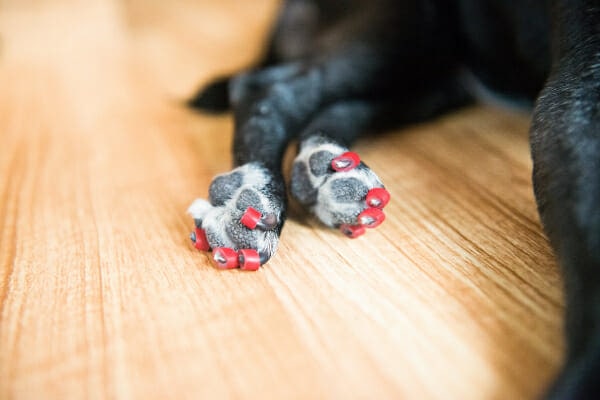
ToeGrips can be a game-changer for dogs who are struggling to get traction. Additionally, the extra security that ToeGrips provide allows a dog to walk more confidently and decreases the risk of becoming injured by slipping and falling.
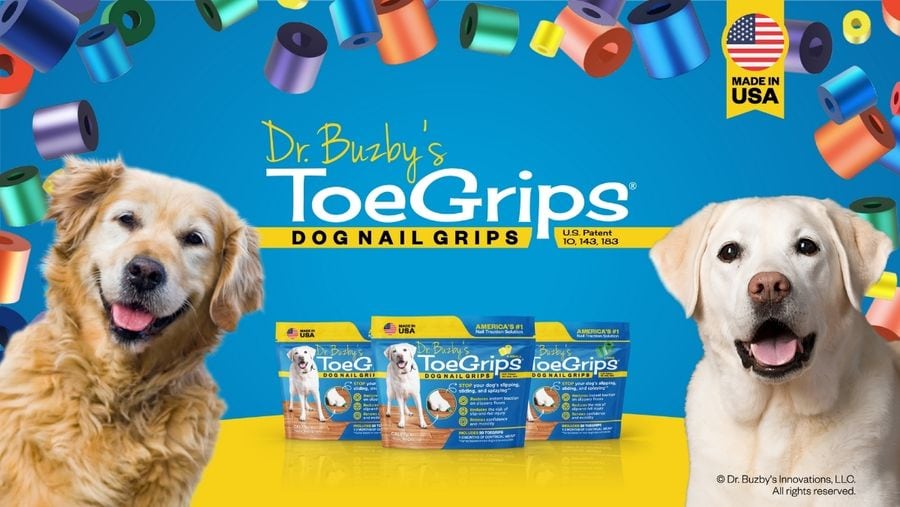
Weight management
If your dog is overweight, your vet may make some recommendations to help your dog lose weight. Excess bodyweight puts more stress on the joints which leads to more pain. When a dog gets back to an ideal body condition score, he or she is often able to move around more comfortably.
Regular low-impact exercise—Should you walk a dog with luxating patella?
If you are wondering, “Should you walk a dog with luxating patella?” the short answer is “Yes!” Dogs with a luxating patella can greatly benefit from walks. Since weight management is a big part of the non-surgical treatment of luxating patellae, daily walks can help burn excess calories. However, it is possible to overdo it on the exercise. Running and jumping can accelerate the wear-and-tear on the cartilage that covers the ends of bone, thus speeding up the development of arthritis.
Even if you pursue surgical treatment for your four-legged companion, walking will be an important part of his or her recovery. In the initial two weeks of healing, your vet surgeon may limit your dog’s walking habits. Once two weeks have passed and adequate healing is confirmed, the doctor may tell you to gradually increase activity. This is because thigh muscles tend to atrophy (i.e. shrivel) if full weight is not placed on the limb (think about how astronauts living on the International Space Station have to exercise daily to prevent muscle weakening).
Additional therapy modalities
There may be other treatment modalities that your vet will recommend such as:
- Luxating patella dog massage — deep tissue massage may help with muscle contracture and lymphatic massage is useful to help reduce inflammation after surgery
- Physical therapy — to ease muscle tenseness, build muscle, and improve mobility
- Acupuncture — for pain relief
- Laser therapy for dogs — to reduce pain and inflammation
- Underwater treadmill for dogs — to help with weight loss and build muscle strength
- PEMF therapy for dogs (pulsed electromagnetic field therapy) — for pain relief
Luxating patella dog surgery
Dogs with a Grade III or Grade IV luxating patellae often need surgery to keep them comfortable and mobile. Additionally, while early intervention with medical management may help prevent a Grade II luxation from worsening, it isn’t always successful. Sometimes, the trochlear groove may wear down over time, causing the luxation to progress to a Grade III. Or a dog may become significantly painful even with a Grade II luxation. In those cases, it may be time to consider surgical correction.
Some general practice vets may be able to perform luxating patella surgery. However, because knee surgery is not a common procedure, your vet may refer you to a small animal orthopedist who is boarded through the American College of Veterinary Surgeons (ACVS).
There are several different surgical techniques that the surgeon may use for dogs with luxating patellae. The technique selection will depend on the severity of the luxation, your dog’s size, and if there is additional structural damage inside the knee. If both knees require surgery, the surgeon may choose to correct both at the same time if the patient is young. For older dogs or for those with other health issues, the surgeon may choose to separate the procedures by eight weeks or more.
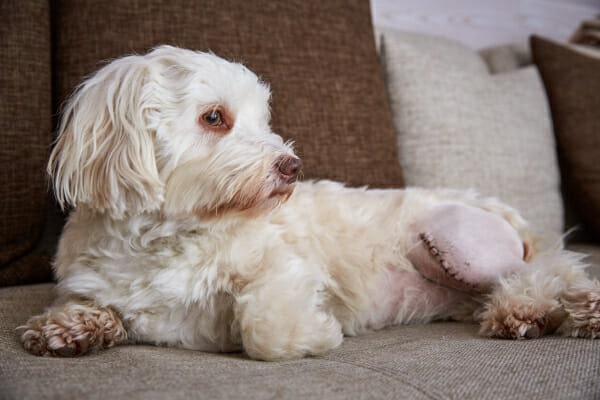
Lateral imbrication surgery
For mild cases, the surgeon may recommend a lateral imbrication (i.e. lateral reinforcement). This is a simpler technique where the vet will tuck or tighten the joint capsule surrounding the patella on one side to prevent the patella from luxating. In some cases, the vet will also loosen the capsule on the other side so the patella doesn’t get pulled to that side.
Trochelar modification surgery
Another option is to deepen the trochlear groove so that the patella can stay within the groove instead of luxating. In order to keep cartilage safe during surgery, the surgeon will remove a slice of bone from underneath the cartilage. Then he or she will put the cartilaginous part back into place. This preserves the cartilage’s ability to help the ends of the bone glide over each other and absorb shock when the dog moves.
Tibial crest transposition
Dogs with a bow-legged stance may need a tibial crest transposition or tibial tuberosity transposition (TTT). This procedure involves removing the tibial crest (i.e. tibial tuberosity) where the patellar ligament attaches and then pinning it back in a new position to correct the abnormal forces across the joint.
Ridgestop™ implant
In some cases, the surgeon may select a newer technique which involves the use of a Ridgestop™ implant. The procedure involves using a small curvy metal plate to increase the height of the trochlear groove ridges. This keeps the patella from slipping out of place.
Dogs may require a combination of these approaches as well, and this is not an exhaustive list of surgical options. The best way to know what sort of surgery is right for your dog would be to consult with a board-certified veterinary surgeon.
To learn a bit more about some of the surgical options and the decision making process you can also refer to this article from Vet Times, Canine Patellar Luxation Part 2: Treatments and Outcomes.
Luxating patella surgery recovery
For the average luxating patella dog, surgery recovery can take six to eight weeks. This can sometimes be shorter if the surgeon used the lateral imbrication technique. On the other hand, recovery can also take longer than eight weeks if the dog needs physical therapy.

As a general rule of thumb, a dog should be able to bear weight on the limb after two weeks. If he or she is still not using the limb properly after one month, physical therapy may be a good idea. However, this can vary between procedures. It’s wise to ask your surgeon what to expect in your dog’s particular case.
Initially, strict crate rest or confinement to a large pen is necessary following surgery. Your dog’s surgeon may also use a cast or bandage material to protect the surgery site and prevent excess movements.
After the first two weeks, light walking may be acceptable, but dogs should not be permitted to walk off-leash. Running and jumping are also prohibited. Again, please follow your surgeon’s instructions about exercise as they will be tailored to your dog’s exact situation.
When proper surgical aftercare is used, the success rate of luxating patella surgery in dogs is quite good. According to the ACVS, more than 90% of dog owners are happy with their pup’s mobility post-surgery. This percentage decreases slightly for large breed dogs, usually because they are more likely to have lameness that is multifactorial. For most dogs, the chances of an infection are quite low, and the odds of implant failures or recurrence of joint instability are lower still.
Talk to your veterinarian about luxating patella options for your dog
The good news is that, as you can see, there are many options available to help a dog with a luxating patella. It doesn’t have to spell the end of your dog’s ability to participate in activities, especially for dogs with a Grade I or II luxation. Even if your dog has a higher grade luxation, there are a wide range of surgical options which are generally quite successful.
If you see your dog limping or walking “funny,” be sure to bring it up to your veterinarian as soon as you can. Prompt identification of luxating patellae can lead to faster treatment. Plus, early intervention may help prevent future joint pain. Together, you and your vet can do everything possible to set your dog up for minimal pain and maximal enjoyment of life.
Does your dog have a luxating patella?
Please share your experiences below.


Hello Dr. Buzby – all,
About two weeks ago we went to the vet with what we thought was only a laxating patella on our 1 year old maltipoo pup. After X rays we discovered she had laxating patella on both knees, grade II and III, and also hip dysplasia on both legs, mild to medium on one, and on the other, still not clear to me… spoke to couple of vets but I feel I got different info every time. Some spoke about severe laxation… others said the the HP is mild to medium… I am confused and have the worst in mind. This was absolutely shocking and devastating to us… She was never involved in any accident… yes, we played with her a lot (?), maybe twice a day for an hour each time and this involved walks in the park, playing with other dogs, running, chasing the ball, or just walking… was it that much that it could have caused some many issues?
We felt helpless and started questioning if this was our fault, what did we do wrong, etc. I still feel pretty devastated…
We were told that since she doesn’t show clinical signs for the hip dysplasia, there isn’t a need for a surgery (atm at least). We are booked for a surgery on both knees together on the 13th January 2025. Though grade II and III, she shows signs on both with hopping on the left leg and having her right knee popping out every now and then…
Any thoughts on this would be much appreciated…
Hi Daniela,
I am sorry your pup is facing so many orthopedic issues at once. Please don’t carry around guilt over her situation. These problems don’t occur due to exercise or even accidents. Luxating patella and his dysplasia are genetically passed on from the parents. There was no way you could have prevented this. I am glad you are pursuing surgery for your pup’s knees and would highly recommend staring a good quality joint supplement. I will attach links to other articles with ways to reduce inflammation and pain. Hoping we can make hip surgery unnecessary or at least postpone it for several more years. Wishing your sweet girl all the best and keep up the good work!
1. Natural Pain Relief for Dogs: 17 Methods from a Vet
2. Medicine for Hip Dysplasia in Dogs: 10 Tips for Treating Hip Dysplasia
3. How to Relieve Arthritis Pain in Dogs: The Ultimate Guide
Hello, I was gathering information on PL and found your page. My toy poodle had MLP on his right leg and got surgery mid September. I would like to know whether limping on the operated leg after the procedure is part of the recovery process? As of now, the limping/skipping looks just like before the surgery, and I was wondering whether or not I should be concerned about this. I’d appreciate it if I could get a reply, thanks.
Hi Jade,
I am sorry your Poodle is still having lameness issues despite having surgery a few months ago. While the affected limb may never be completely “normal” it does surprise me that there has been no improvement at all. I do think you should pursue a recheck with the surgeon and get their expert opinion. Hoping for clear answers and a positive outcome for your pup. Feel free to leave an update and let us know how things are going.
Hello! I have a little 6 lb Papillon who is now almost 2 years. I bought her as a pup knowing she had a LP of 1 in her back left leg. A year later, at her wellness check, the vet looked again at her leg and all was good & still mild LP 1-no change. The vet gave an okay to do activities (we do agility) with the caveat that later my girl would likely have arthritis in her later years. Due to no availability at the training facility, I waited to do any training, and was shocked when 4 months later at a vet appt for her boarding shot, we were told she now has a LP 4 in one leg & a LP 3 in the other (approx 16 months old then). She shows NO symptoms, no pain, no giddy-up, nothing that would indicate this drastic change. Is it possible that the legs could change that much & that fast in 4-5 months (in a young dog) with only normal activity? The vet said no to surgery, and just to limit jumping, but that was all. Do you have any further suggestions?
Hi Tonja,
I am sorry your girl is living with this knee issue. What a blessing she doesn’t have any pain and is able to function normally. I have definitely seen cases where a luxating patella progresses quickly when there has been no injury or other such event. I would highly recommend you start a good quality joint supplement now. This will help to protect the joint and try and save the cartilage and synovial fluid that acts as a cushion for the bones. I am hopeful that your girl will go on to live a full and happy life. Wishing you all the best and keep up the good work!
Good morning Dr Buzby,
I have an 8-9 lb Chihuahua / Min Pin, probably with a dash of Dachshund (since her back is a bit long.) She is about 11 inches tall. Over the last 6 month we have notices what we call a hitch in her giddy-up with her left hind. I am told she may have a luxating patella but the vet we saw (Chiropractic trained vet) seemed to think it was fine at the time. It is very pronounced when she is at a trot. Not when walking or running faster as in a recall. Are there other things it ay be or should we try again at the vets? She does not seem to be in any pain.
Thank you so much for you time
Hi Nancy,
I understand your concern for your girl with this lameness she has developed. From what you describe, it does sound like she may have a luxating patella. Of course, without examining her myself, I can’t make specific conclusions. With a luxating patella, you may not notice an issue when your girl is running fast because they will generally just pick up the affected leg and hold it up while running. It is normal for this condition to be painless (most of the time) if only a grade 1 or 2 is present. You may start to notice more discomfort as this progresses with time and the grade increases. It is a good idea to mention this to your regular vet at your pup’s next checkup. They can let you know if any treatment needs to be started (supplements or anti-inflammatories) and monitor her condition moving forward. Wishing you all the best and give your sweet girl a hug for me!
Hello Doctor Busby., Our almost 4 year ikd Mini Auaaie (28 lbs) has patella luxation in both knees. Left is level 2 and right is level 3. We are going to have the surgery to correct both. We are wondering if there is an issue with having both done at the same time versus one at a time. We want her to have the least amount of trauma as possible and figured once may be better than twice. Would appreciate your thoughts.
Thank you for your time.
Hi Douglas,
I understand your concern for your pup and think it is great you are planning to move forward with surgery. I get asked this question from time to time and unfortunately there isn’t a straight answer. Either option can be a good way to proceed. Both have their benefits and issues. If you do both knees at the same time, you may have more trouble getting your girl up and moving to start the rehabilitation process since both knees will be weakened and painful. But I think I’d personally rather get it done with and not have to go through another surgery, anesthesia process, and recovery period. Hoping you can find the advice you need to feel confident with whatever choice you make. Wishing your girl all the best with her surgery and praying for a full recovery.
Hi, my 5 year old Chihuahua was diagnosed with locating patella. He walked fine until we took him into the vet, they tried to do x-rays and he was fighting them and after we left and they couldn’t get him to cooperate to do the x-rays told us to watch him and if it continued they will have to do x-rays and sedate him. When we left he could barely walk, we thought it was the trazadone so as the next day came around we called. Long story he got sedated and did x-rays and showed us his knee. Told us to keep him in confined area for 2-3 weeks and gave him anti inflammatory and arthritis chews. It’s been a week and a half and he still walks a little sideways, no limp but doesn’t walk right and slips all around on hardwood floors so we have a bunch of rugs layed out. Any thoughts or advice? Thanks!!!
Hi Carina,
I am sorry your little pup is having issues with his knees. If rest and medical management isn’t able to improve his condition, you may need to consider a referral to a specialist or discuss the possibility of surgery. He is lucky to have you advocating for his health and well-being. Hoping you can find the answers you need to restore your sweet boy’s quality of life. Best wishes and keep up the good work.
Hello Doc,
I have been a large breed dog parent for years however, I am now a Yorkie parent. I brought home a 10 week F, who is now at a stage one. Is there anything different than the above steps I should take for such a young pup? Thank you for your advice and your information.
J
Suffolk, Va
Hi Jake,
I am sorry you are facing this condition in your young pup. My best advice is to try and keep your girl’s joints as healthy as possible. The more you can do for prevention now, the better things will be in the long run. I would go ahead and start a good quality joint supplement. Keeping the cartilage in the joint healthy and nourished will go a long way to preventing arthritis formation. I will attach some links to other articles with good information. While they focus on addressing arthritis after it has formed, the treatments mentioned are also wonderful at helping to prevent arthritis in the first place. Also, regular wellness exams by your vet will ensure you know how things are progressing and they can let you know if you reach a point where surgery would be helpful. Wishing you and your little pup the best of luck!
1. Natural Pain Relief for Dogs: 13 Methods
2. Adequan for Dogs: Don’t Just Treat Arthritis, Slow it Down
3. How to Relieve Arthritis Pain in Dogs: The Ultimate Guide
4. Osteoarthritis in Dogs: Everything You Need to Know
Hi. The article was very informative, thank you. I have two questions though first I want to say my vet has confirmed my 15lb Silky Terrier does have luxating patella. Recently when he was sleeping I reached over to pet him (yes he is in our bed) and it startled him and he jumped up and screamed in pain and looked at my like I hurt him. Ever since then he is wary of me and my heart is broken that he must think I hurt him. I am guess his knee slipped out while sleeping or when he jumped up. How can I regain his trust after this? Secondly and most importantly is a hard surface better for him to sleep on than a soft surface for this issue?
Thanks so much!
Hi Jen,
I am so sorry you experienced this difficult situation with your pup. I can only imagine how worrisome it must be knowing the bond you shared has been broken because of this issue. The best way to earn back his trust is to make sure that your interactions are positive and be intentional about spending quality time together. I am not sure that the sleeping surface will have much of an impact on his luxating patella, but if he is painful then I would definitely recommend soft but supportive bedding. Also, if this is causing daily pain, your boy may be a good candidate for surgical correction. I encourage you to discuss treatment options with your vet and even schedule a consultation with a specialist if needed. Wishing you both the best and praying for a positive outcome.
Hi Dr Buzby,
My 13month old Lab Doug has Lateral LP in both legs, grade 1. We are doing hydro and targeted exercises and have him on a diet to help his joints as well as a supplement.
Our vet has said to limit high impact exercises like running and playing etc which is fine and surgery isn’t required until it gets worse or if he shows signs of major discomfort.
As young Lab he has a lot of energy and sometimes is sore but he is managing well, I think the hydro is helping. However none of it is covered by pet insurance and it is very expensive and I feel that all the prevention of injury is limiting his life…when realistically he will probably require surgery down the line (for his LP of a ligament injury from the LP).
I was wondering if there is a time frame I can incorporate playing with his dog friends again maybe when he is fully grown?
I would still incorporate the hydro and keep him on his diet but it is heartbreaking having to leave him at home if we are going somewhere where there is another dog because the risk of him playing rough and injuring himself is too great…I just dont think its fair to do forever and is a bit sad for him.
Or will the risk always be there even when he is fully grown and its just a wait and see situation..? I just want to know what to do as nobody will give me an answer…limit his life incase or let him have responsible fun once his bones are grown and keep hydro in??
Hope this makes sense, thanks!!
Hi Jane,
I am sorry Doug is facing an uncertain future due to his joint issues. I understand your concern and wish I had some great advice. Unfortunately, the risk of the LP worsening with high impact exercise will always be an issue. Most of my clients are not willing to restrict the activity of a young pup so we end up monitoring the progression of the LP until surgery is recommended. The choice is yours and you have to do what you feel is best. I am not sure there is truly a right or wrong way to proceed. I do think the hydrotherapy is a good long-term treatment, but also understand how it could be cost prohibitive. I highly recommend you talk to your vet and discuss these concerns. They may be able to offer alternative treatments that would allow you to decrease the frequency of the hydrotherapy sessions but still give Doug the most benefit. I will attach links to other articles with more information about treatments such as: acupuncture, Adequan injections, Encore Mobility, laser therapy, etc. I am hopeful you will find the best path forward. Wishing your sweet boy a long and happy life.
1. Adequan for Dogs: Don’t Just Treat Arthritis, Slow it Down
2. 3 Natural Supplements for Dogs Like Yours
3. Natural Pain Relief for Dogs: 13 Methods
4. How to Relieve Arthritis Pain in Dogs: The Ultimate Guide
Hi Dr. Buzby,
My 6year and 8month old Bishon boy has a medial patella luxation in his left leg and a lateral luxation in his right leg, both legs are grade two. I gave him many joint supplements such as msm, green lipped mussel, egg shell membrane powder, collegen, and have tried accupuncture, physical therapy, and Chinese medicine, but it didn’t seem to help him much. He has no symptoms of pain but I am worried that he might develop arthritis as his age grows. How can I help his condition to get better and should I consider surgery?
Hi Chrissa,
I understand your concern for your pup and think it is great you are reaching out for advice. All of the things you have already incorporated in your dog’s treatment plan sound amazing. You are doing such a great job. Just know that supplements and physical therapy all help to keep inflammation decreased and increase the health of the affected joint. They cannot “fix” the problem. The only way to correct the issue of a luxating patella is with surgery. Since your pup has no symptoms of pain and seems to be doing well, surgery may not be warranted at this time. I highly recommend you schedule a consult with your vet or the surgeon that would be doing the procedure and get their expert opinion on your dog’s case. Unfortunately, a luxating patella will predispose your boy to forming arthritis in his knee joints at some point in life, but surgery carries this same risk as well. The best way to keep arthritis at bay for as long as possible is to use the supplements and therapies you have already initiated. Wishing you and your sweet boy nothing but the best. Keep up the good work!
hello doctor. my dog Dino is a large lab pit mix.has luxatimg patella surgery in right leg appx year ago,now a small piece of bone floating around is causing him pain. in leg already operated on. also he has started to limp on what was good leg now. is surgery only option ? he is not even 2 years old and I am so sad to put him through 2 more additional surgeries. will he be able to have normal conformable active life??
Hi Julie,
I understand your concern for Dino and am so sorry he is having these complications. Unfortunately, without personally examining him, I can’t make specific conclusions or recommendations. Since Dino’s case seems to be very complex, it may be best to ask for a consultation with an orthopedic specialist. They can give you all the details about treatment options and the prognosis associated with each one. Hoping you can find the answers you need to make the best choices for you and your boy. Wishing you both nothing but the best!
I have a 10month old lab who went into season and then began limping. Not knowing if it was pain related to abdomen or relaxed joints from the hormone I watched and waited and she’s been confined to a small indoor space anyway. After 2 weeks the intermittent limp hadn’t improved and took her to the vet and they said she has grade 3 patella location. No imaging yet. My dog has never had an injury and has never been walked or run hard because as a big breed dog I was waiting until she grew before strenuous activity. I’m kind of devastated and not sure how we ended up here
Hi Fiona,
I am sorry your pup is facing this difficult diagnosis and I understand your concern. This condition does not have to be proceeded by an injury or over activity. This can be something genetic that was passed down from the parents. I am certain you have not done anything wrong, and your sweet girl will get the best of care. Hoping you can partner together with your vet to find a clear path forward that will offer your pup the best quality of life. Wishing you both many happy years ahead.
Hello Doctor,
Our boy, (labrador retriever), had a patella luxation surgery – Grade 3 in oct 2021. He has recovered very well and has been walking and running around.. We currently live in El Paso Tx and considering a move to another city. later this year. His ortho had indicated to us during a follow up visit in 2021, that if we move to a colder city we may have to be consider his knee issue. he still has metal plate and may be screws in. Question is, will he have to go through another procedure or do you think he will have health issues due to cold weather.
Hi Subu,
I understand your concern for your boy and think it is great you are taking his health into consideration while contemplating a move. It is true that very cold temperatures can sometimes cause pain in joints that have metal implants. Think about the metal becoming cold and then causing a change in temperature to the surrounding tissues. Also, just like in people, changes in weather can cause discomfort in arthritic joints or areas of a previous injury/surgery. I am not sure what area you are looking at for your new home. But even if the climate is very cold, there are many things you can do to help prevent this from becoming a major problem. You can utilize wraps, leg warmers, etc. and the use of a good joint supplement can be a big help. Hoping you can make a decision that is best for everyone involved. Wishing you and your sweet boy a bright and happy future.
Good day,
My 1-year-old teacup miniature schnauzer recently had surgery for her bilateral MPL. I am wondering, what is the best way to help support her for potty time? She has been home less than 24 hours, but he’s yet to eliminate in any form. I’ve tried using potty pads instead of outside with a leash with no success. Any suggestion to help support out encourage her to potty,
Thanks!
Hi Lynn,
You can try using a small towel or other soft item to sling under her belly to help support her weight. There are several companies that make hip support harnesses specifically for dogs. One that I have had great success with is the Help ‘Em Up Harness brand. You may not want to invest in a harness if you think your pup will only need help for a short period of time. How are things today? Hoping all is well and your sweet girl is making a full recovery. Wishing you the best of luck.
Hello, I have a 2 y/o that we adopted last May. I took her to the vet today for eye infection meds and the vet also diagnosed a luxated patella and it was added to her medical record so we cannot get her on insurance now. We cannot afford $1000-5000 surgery. She is a high energy chihuahua and loves to play. So it will be hard to us to keep her from playing. Any suggestions?
Hi Tiffanie,
I am sorry your little pup is having knee issues. If surgical correction is not an option, then you can always try medical management. I recommend starting with a high-quality joint supplement to help protect the joint and keep it as healthy as possible. There are also numerous ways to decrease pain and inflammation (as things progress) without medications. Here is a link to another article with additional information: Natural Pain Relief for Dogs: 13 Methods
It is always a good idea to be honest with your vet and discuss your concerns. They can let you know which treatment will be of most benefit for your dog’s specific situation. In the meantime, if you know surgery is being recommended, you can start saving and possibly make it an option in the near future. Best wishes and good luck!
HI,
We have a 13 y/o old adorable and sweet maltese dog. He was diagnosed to have heart problem and patellar Luxation grade 3 and 4 on hind legs. We see that he is having challenge with the patellar condition, there are times that when he walks he would hop from behind on the next step. We are giving him from time to time pain medication but due to medications for the heart we try not to give him so not interfere the treatment. And the his doctor did not recommend surgery anymore due to age. I have been searching and looking how to help manage discomfort for his luxation but most I see is for lower grades. May I ask if you have recommendations as to pain and discomfort management for grade 3 and 4? It’s heart breaking to see him change and fighting.
Hi RSB,
I understand your concern for your senior pup and his knee pain. I am sorry his heart condition prevents him from being an ideal surgical candidate. Unfortunately, the recommendations for reducing pain and inflammation are the same no matter what grade of luxation your dog is experiencing. There is only so much medications can do. Here is a link to another article with additional information and other ways of treating pain you may not have considered: Natural Pain Relief for Dogs: 13 Methods
I hope you can find the best way to help your little dog and give him some relief. Wishing you the best of luck.
just was reading your comment I also have a Chihuahua 11 years and afraid of doing surgery at her age have you thought about getting a vet to help size your dog with a brace that would help support your dog’s legs I’m thinking of trying that if I can get fitted right to be able to support the legs to help
We just discovered that our 2-year-old toy pomeranian must get luxating patella surgery. I am so nervous because my husband and I work full time and we are unsure if we will get any time off from work to help her on her recovery journey. We also have limited family members that stay close to us which can actually help with the recovery process as well. My question is, how will this situation influence our pup’s recovery process? I am so scared that she won’t recover properly. Any advice regarding the recovery process and what will be best for our pup will be much appreciated.
Hi Shannon,
I understand your concern with the recovery process while you are away from your pup during the day. Try not to worry too much about the “what ifs” as this is completely doable! You may have a couple hard weeks, but things will get easier as each day goes by. In general, while you are away, make sure your girl is in a small space where she will spend most of her time resting. The most important thing is to keep her from too much activity until it is the appropriate time to start increasing her movement. So, if she can sleep in a crate while you are away, this would be ideal. Then when you are home you can start to do her exercises or stretching as prescribed by the surgeon.
Hi Dr.Buzby,
I rescued a street dog I found in July. He is roughly 2 years old. When I found him he was limping back and forth on one side. Once I brought him back to the states, I was told its luxating patella, He was malnourished and underweight. After 3 months he became a different dog. I havent seen any limping anymore. He has a funny walk and hops like a bunny whenever hes out and about and he stretches his back legs I’m assuming to keep his knees in place. I got him evaluated by an orthopedic surgeon who recommended surgery one leg at a time. Said both legs have the luxating patella but one is worse than the other and it could eventually lead to arthritis, Ive having his surgery tomorrow and am concerned for the recovery. He slips on any hard floors and now tries to avoid any area that isnt carpeted. Do you recommend toe grips for him? Also he jumps when he walks even on a leash its just a happy walk where he hops every step of the way and am unsure how to calm him down during the recovery. Any advice?
Hi Ella,
I am sorry your pup is struggling with a luxating patella in both knees. What a blessing you found him and were able to give him a new start in life. I definitely think ToeGrips could help give your boy the traction he desperately needs when walking on slick surfaces. If you decide to give them a try, please let me know what you think! As far as the jumping while he walks, I imagine he will probably be less willing to try this after surgery just due to the challenges of the recovery process. Slow controlled walks on a leash are best and if you think you will need something to help keep your boy a bit sedated just ask your vet. I hope the surgery went well and things are progressing smoothly. Feel free to leave an update if you have a chance.
Hello Dr Buzby,
My 2 year old 10 lb terrier mix had grade 3 luxating patella in both knees and was limping/waddling along. I had both knees done at once (easier to handle than I expected) and was ultra vigilant in recovery and PT. He appears to be walking and running perfectly, but when I pick him up I would always feel a clicking, I thought it was in his hips. They checked everything and found nothing. But it became much more constant so at his annual checkup I had them focus on this and they found one of his knees still has a grade 1 /2 luxating patella. Since this seems to have become more noticeable in 6 short months, and we are fairly active (walk 3 miles a day, occasional hikes, lots of fetch and were planning on doing agility classes for fun until this latest diagnosis) I’m wondering about what the future looks like. At grade 1 or 2 I don’t think I would consider surgery again, but will this get worse? Vet s ays it pops out once every 5 manipulation.. Is this potential for future arthritis? SHOULD I be considering a second surgery now or in the future and is that even done?
Hi Mia,
I am sorry your young pup has had so many issues with his knees. Without examining your dog myself, I can’t make specific conclusions or recommendations. Any abnormal movement of a bone or joint will contribute to arthritis formation in the future. You may be able to prevent some arthritis with the help of supplements, exercise, and other treatments such as laser therapy. There is no way to know for sure how these knee problems will progress or if it will progress at all. My best recommendation is to have your boy evaluated by the surgeon who did the initial surgeries. They can let you know if an additional surgery is recommended or what to watch for as a sign of needed intervention in the future. Some dogs do require more than one surgery in their lifetime. I hope this helps a bit and may give you some guidance as you discuss your concerns with your vet. Wishing you the best of luck for a positive outcome and a full recovery for your little guy.
Hi Dr. Buzby
Thank you for sharing your knowledge and responding to comments above. I have an 11lb, 4 year old Bichon/poodle mix, who has stage 3 and 2 Luxation. I saw an orthopedic surgeon and the recommendation is surgery and I will proceed with it since she has developed arthritis on right knee. My question is, should I do both legs at the same time? The surgeon recommended doing right leg that is stage 3 but to wait a bit for the left leg (he said it might not even need surgery, it is waiting game) My concern is that I don’t want her to be “under anesthetics” another time and recovery is long, it will be so hard on her body. What are your recommendations?
I would greatly appreciate your response.
Hi Elly,
I understand what a difficult decision this must be. I am glad you have talked with the specialist and received their expert opinion. If both knees were severely affected, then I would lean more toward having both fixed at the same time. Since only one knee is a high grade, and the surgeon thinks the other may not need surgery, I would go with their advice and only fix the worst one. Also, I highly recommend you look into getting your girl started with a veterinary rehabilitation professional. They will be able to monitor her progress during recovery to make sure things are healing on schedule. A rehab vet can also give you exercises to do at home or recommend therapies to make sure the other knee stays healthy for as long as possible. I hope your dog’s surgery will be successful and she will make a full recovery. Best wishes to you both.
My 7 month old Chihuahua has luxating patella’s in both knees. They are stage 3-4. She doesn’t seem to be in any pain but they went from a one to 3-4 in 4-5 months. She only weighs 5.6 lbs. I’m going to get an appointment with an orthopedic surgeon. Do you think it’s too early to tell if she will get any better or is it likely it will continue to worsen. And what will they outcome be. Do they normally become healthy disease free after the surgery? Thanks
Hi Rhonda,
I am sorry your little pup is struggling with a luxating patella in both knees. I am glad you are planning to schedule a consult with an orthopedic specialist. In my experience, this issue does not improve on its own and will continue to progress without some type of intervention. Yes, the surgery will correct the issue and prevent the patella from luxating so easily. I am sure the surgeon will explain everything in more detail. Make sure you have your list of questions and concerns ready before the appointment so you can get the answers you need to make the best choice for your sweet girl. Wishing you both the best!
My Boston Terrier has grade 1-2 luxating patella in both knees. His knees pop out occasionally and go back into place on their own. Doctor recommends surgery, but said he can only do one knee at a time so pup can walk after recovery. I was told previously that he could do both knees at the same time. The thought of two surgeries and two lengthy recoveries scare me, any advice?
Hi Jessica,
I understand your concern with having to endure two different procedures and the recovery period post-op. With that being said, I also see your vet’s concern with your little guy needing to have one usable leg to get around during recovery. I have seen it done both ways and feel like it is mostly surgeon preference. You may want to let your vet know how strongly you feel about having both knees done at the same time. If they still decline, it would be an option to reach out to other surgeons in the area. I hope you can find the answers you need to make the best decision for you and your sweet boy. Wishing you the best of luck.
I have a 12 1/2 year-old toy poodle who has a lactating patella it’s in stage 4/5 I have an appointment at the end of the month at an orthopedic surgeon but so concerned about this big surgery at her age any suggestions
Hi Elaine,
I understand your concern for your senior girl and this possible upcoming surgery. I always recommend dogs have the necessary pre-op lab work and testing to make sure there are no underlying issues that would make anesthesia especially risky. If your pup’s test results are normal, then I vote yes to surgery. We know the surgery will help decrease her pain and discomfort and improve her quality of life. Age alone is never a reason to avoid a life-giving procedure. I will attach links to other articles that may offer additional information and comments from other readers. I hope you can find the answers you need to make the best decision for you and your sweet girl. Best wishes to you both.
1. Is My Dog Too Old for Surgery?
2. Is My Dog Too Old For Anesthesia?
Great information! My question is in regards to when we should let our dog sleep in the bed with us? He’s two weeks out with staples removed. His recovery is going great and will have PT this upcoming week. My with wants him back in our bed where he’s normally sleeping, yet I don’t want to rush. I’m worried he’ll jump off the bed, if he hears one of our cats scratching the door.
Hi Joe,
This would be a great question for your rehabilitation veterinarian! After evaluating your pup and starting PT, they will have a good idea of what activities and behaviors are ok for your dog or what should be avoided. Also, they make small ramps or stairs/steps that your dog can use to get off the bed without having to jump. I hope your sweet boy will continue on the path to a full recovery. Best wishes!
My three year old, 7.8 lb Yorkie (who is not overweight) has what his vet described as a stage III to IV case. He is very active, fast as lightening and jumps all the time. However, on about 4 different occasions he has started holding up one hind leg that seemed painful. A little massage and within a few minutes was fine again. Should I just let this progress since it isn’t causing any real quality of life issues, or should I have him assessed for surgery. I would hate to put the little fella through surgery!
Hi Marcia,
I understand your concern with the possibility of surgery and your young pup. In my experience, the surgery is easier and more successful if done earlier in the disease progression. Most surgeons will want to do the procedure before lots of scar tissue, inflammation, and joint changes have occurred. It would be a good idea to schedule a consult with a veterinary orthopedic surgeon and see what their recommendation is for your dog’s specific situation. I hope you can find the best way to get your little guy pain free and living his best life. Best wishes and good luck!
I adopted a 6 lb senior ( 12 -15 years old) Chihuahua 7 months ago. She is the sweetest little dog. She had to have 17 teeth removed. She was cleared for anesthesia as she also has a low grade heart murmur. She has walked with a bit of a rear waddle and was diagnosed as arthritic. Monday morning she sat down in the yard and could not get back up. I took her to the ER vet who diagnosed her with luxating patella in both knees after X-rays. She did not offer a grade level but said she was able to pop her knee back in. I have an appointment today at her regular vet. After researching the diagnosis, I am so concerned about her not being a good candidate for surgery. Is pain management-although she does not appear to be in any pain at this time- and use a rear wheel cart an option for a tiny senior? Thank you for a wonderful article. I’m assuming my regular vet will recommend an orthopedic consult.
Hi Linda,
I am sorry your little Chihuahua is having mobility issues with her rear legs. She is lucky to have found you and have you advocating for her health and wellbeing. Pain management and carts are great options for tiny senior pups! Although I wouldn’t think your girl would need a cart unless it is found that she also has a neurological issue that has rendered her paralyzed in the rear limbs. If this is truly an orthopedic/arthritis issue, then pain management and physical therapy could do wonders for your sweet girl. Like you mentioned, a consult with an orthopedic specialist is a great idea, and whether they recommend surgery or not, I recommend you talk with a veterinary rehabilitation specialist. Rehab/physical therapy is a great way to either prepare your girl for surgery and recovery afterwards or help decrease her pain level and inflammation if surgery is not pursued. I hope you can find the right combination of treatments to restore your pup’s quality of life. Wishing her a complete and speedy recovery.
I adopted a Jack Rusell Terrier cross two years ago and noticed that she had pain in her back leg April this year. She is approximately 5 years old. The diagnoses was a grade III patellar luxation with the recommendation for surgery. I proceeded with the surgery although it was incredibly expensive as she is still a young doggie and I want her to have the best chance at a pain-free active life.
She had her 6 week post-operation checkup today. All looks well on the X-rays but she still does not put her full leg on the operated leg when she stands and sometimes she limps. The Doc suspects that it might be pain from the cruciate ligament, but suggests a few more weeks of observation and monitoring.
I so desperately hope my pup does not need more surgery!
Do you have any experience of cruciate injury related to a patellar luxation?
Thank you for the informative article!
Hi Justine,
I am sorry your little pup’s recovery from surgery is not progressing as expected. I agree with your vet that it may be good to give it a few more weeks to see if she will start using the leg more. Also, if the vet that performed the surgery was not an orthopedic specialist, then it might be a good idea to talk to a specialist and get their expert opinion on your dog’s knee issues. They can let you know if the cruciate ligament is causing a problem or if this is all still related to the patellar luxation. No matter the source of the pain, I highly recommend you find a rehabilitation vet to start working with your girl. They can help her through this recovery process post-surgery and give you reasonable expectations for how things should be progressing. Wishing you both the best and praying for a positive outcome for your Terrier girl.
Hello Dr. Buzby!
Thank you for such a well written and informative article. My 55 lb Chow Chow mix was just diagnosed with a grade II-IV medial patella luxation. He is only 15 months old and obviously not a small breed dog. My vet immediately recommended surgery, but also said I could wait another few months just to confirm he will not “grow out of it.” The symptoms started after he slipped going down the stairs (we recently moved to a home with hardwood floors, I need to invest in your nail grips) and my insurance is of course denying my claim as a pre-existing condition, stating that a Cranial Cruciate Ligament (CCL) injury is a chronic degenerative disease. It very clearly to me was a result of a traumatic injury.
I am just having a hard time coming to grips with this diagnosis and justifying the need for surgery, given his age and conflicting information. Is it likely that even if he has the surgery, the symptoms will return down the line and he’ll need another? Thank you for your expert opinion and help.
Hi Amy,
I am glad you are reaching out about your Chow’s peculiar case. I think it would be a good idea to have him evaluated by a veterinary orthopedic specialist. They can give you a definitive diagnosis, go over the surgical and non-surgical treatment options, and discuss prognosis for the future. Also, if your pup does have a torn cruciate ligament, your vet should be able to give your insurance company the information they need to correct their statement of it being a preexisting condition. The insurance company is correct that most CCL tears in older adult dogs are the result of chronic degeneration, but that isn’t always the case! This kind of tear can also happen with a traumatic injury just as you have described. Your sweet boy is lucky to have you advocating for his health and wellbeing. I wish you the best and keep up the good work!
If your dog is already at a stage 4 luxating patella what is likelihood with surgery that he will still have to live with the pain of permanent arthritis?
Hi Valerie,
With a stage 4 luxating patella there is definite joint damage and most likely osteoarthritis already in place. X-rays may be able to evaluate the degree of damage already present and a surgeon can evaluate further during the surgical repair. Whether you pursue surgery or not, I highly recommend you have your dog evaluated by a veterinary rehabilitation specialist. They have many different tools and treatment options to help reduce pain and inflammation either post-surgery or without surgery all together.
That is good information to know.
On a (kind of related topic, at least it’s leg related) do you know the cause for a dog whose back legs, sometimes it’s only one but other times it’s both, tremble after vigorous exercise and/or excitement. Our Aussie’s legs do that (never her “arms”) and I’ve seen other dogs do it and ask their people if they know what causes it. I’ve shown two maybe three of our veterinarians videos of our girl’s legs doing the trembling thing but they have never been able to tell me why it’s happening. If I hold her legs or move them to a slightly different position it will often stop. She is eight now and has been doing it since she was several years old. It may happen a little more often now. I just want to be sure it’s nothing that I need to keep a cautious check on. I keep asking people hoping that someone will have the answer.
Hi Amy,
Your Aussie girl sounds like a very interesting case! Without examining her myself, I’m not sure I can really make any guesses as to the cause of her trembling episodes. It does make me think about possible neurologic issues. I am glad you have this on video as it can be hard to replicate exercise related problems in a clinical setting. It might be a good idea to pursue referral to a veterinary neurologist or internal medicine specialist. They may have ideas about a possible diagnosis or testing that could shed some light on this mystery. I hope you can find the answers you are looking for and rule out anything life threatening. If you do find out what is causing the problem, let us know and keep us updated! Good luck to you and your sweet girl.
My 7 year old Lab-chihuahua mix/rescue had his first vet appointment today due to him limping., they said it is most likely luxating patella in box knees. They will be doing X-rays in two weeks to be sure but said it’s most likely the cause. Due to his age and weight they are recommending surgery if it’s the case. My question is what would a double knee surgery recovery look like? I know he’ll have to be confined to his crate, will he have casts? Will he need assistance going to the bathroom?
Hi Brittany,
I understand your concerns surrounding these possible surgical procedures. There should not be a cast placed over the legs after patella surgery. There may be a bandage just for the first day or so to help control swelling and keep the incision site clean. Not all surgeons use bandages after this kind of surgery. Your pup will need assistance for anything that requires standing. You may want to invest in a sling or harness specifically designed for use with the hips/rear end that will make assisting your dog easier. I personally have had great success with the “Help’Em Up” harness. Things should get easier as recovery progresses. You may be glad you had both done at once instead of having to go through recovery again for a second surgery. I am hopeful that all will go smoothly, and your sweet boy will be back to living his best life in no time.